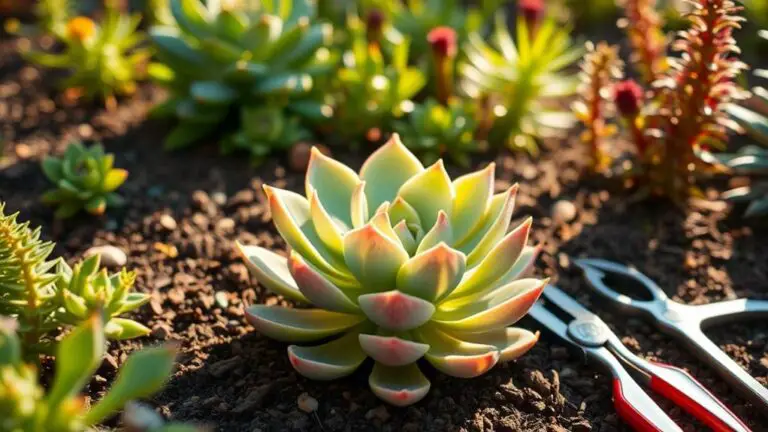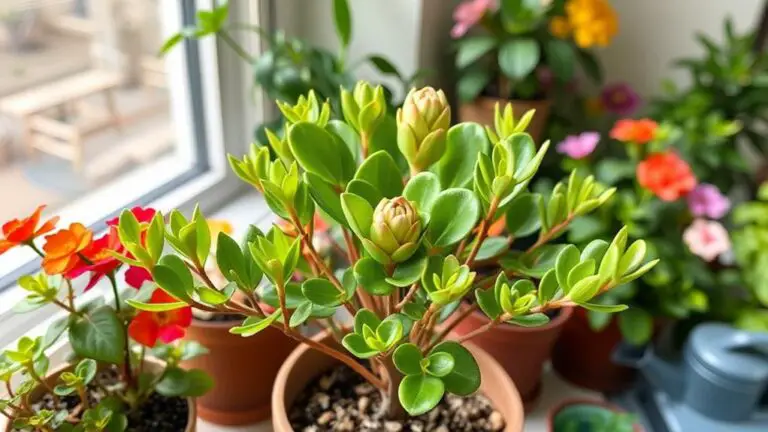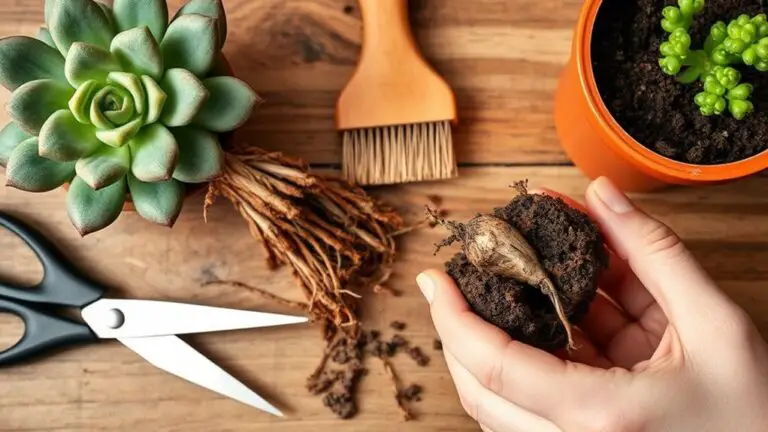7 Steps to Winterize Your Air Plants
As winter approaches, you'll need to take specific steps to guarantee your air plants thrive indoors. It's vital to shift them inside when nighttime temperatures dip into the 40s °F, but that's just the beginning. You'll also have to manage indoor conditions meticulously, from temperature to light exposure and humidity levels. Are you ready to fine-tune your care routine to keep your air plants healthy during the colder months? Let's explore each step, starting with the best timing for moving your plants indoors.
Timing for Indoor Transition
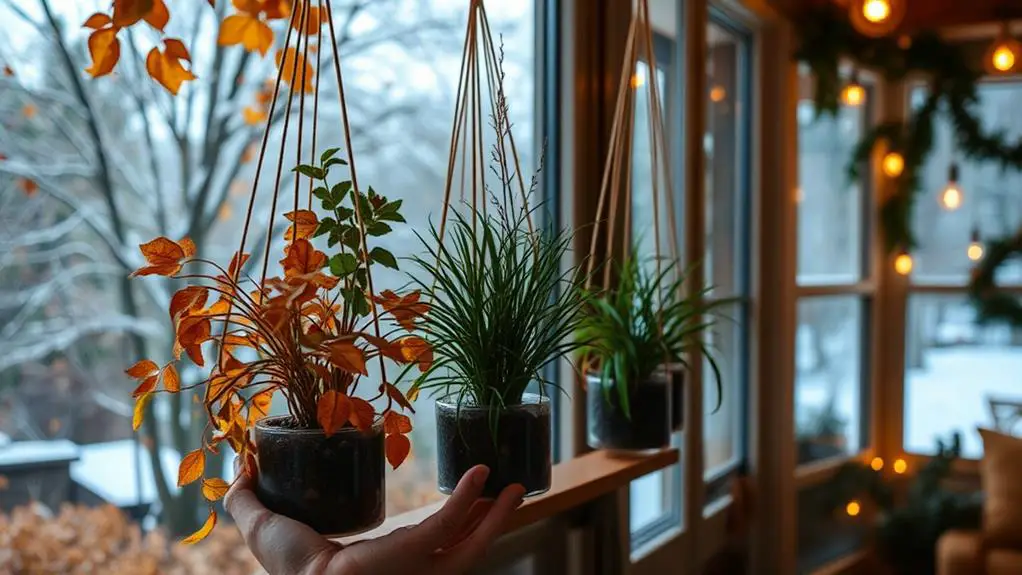
As nighttime temperatures begin to dip into the 40s °F, it's vital to start thinking about moving your air plants indoors to prevent cold stress. Timing is significant for guaranteeing your air plants remain healthy throughout the winter months. When temperatures start falling, it's time to contemplate an indoor shift for your tropical air plants.
To avoid shocking your plants, make gradual shifts instead of sudden moves. Sudden changes in environment can negatively impact air plant health, so it's better to ease them into their new indoor setting. Start by bringing them indoors for a few hours each day, gradually increasing the time they spend inside.
Monitoring local weather forecasts can be very helpful in determining the best timing for this shift. By keeping an eye on the forecast, you can move your plants indoors before prolonged exposure to cold weather causes damage.
Remember, the ideal indoor temperature range for air plants is between 55 and 85 °F.
Taking these steps will help guarantee your air plants stay healthy and vibrant throughout the colder months. By planning ahead and acting thoughtfully, you'll give your air plants the best chance to thrive indoors.
Managing Indoor Conditions
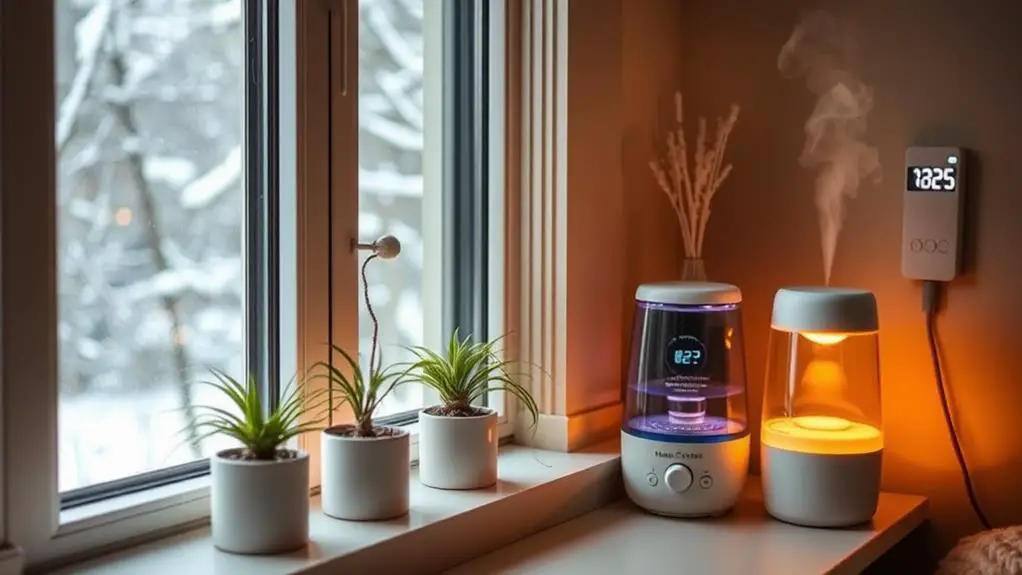
Moving your air plants indoors isn't just about timing; it's also vital to manage indoor conditions properly to guarantee their health.
First, place your air plants in spots with at least 5 hours of bright, indirect light daily. Winter days are shorter, so you might need to use artificial lighting to make up for any lack of natural light. Make sure they're away from fireplaces and heating ducts, which can cause damage from dry air and heat fluctuations.
Maintaining the right temperature is essential. Keep your indoor environment between 55 and 85 °F, avoiding cold drafts and sudden temperature changes. These plants thrive in warm conditions, so a stable temperature will help them stay healthy.
Humidity levels can drop considerably with indoor heating during winter. It's important to monitor these levels regularly and increase misting frequency to combat dryness.
You can enhance humidity by placing decorative bowls or shells filled with water nearby. This small step can prevent dehydration symptoms, like curling leaves or dry tips.
Watering and Humidity

To keep your air plants healthy during winter, it's important to soak them weekly for about 20-30 minutes to guarantee they stay hydrated.
Increase misting to combat the dry indoor air from heating systems, which will help maintain the right humidity levels.
Don't forget to let them dry thoroughly for at least four hours after watering to avoid mold or rot.
Increase Misting Frequency
Indoor heating during winter can create dry conditions that stress air plants. To combat this, you should increase misting frequency to help maintain proper humidity levels. Aim to mist your air plants several times a week, ensuring they get the moisture they need. Regular misting is essential to prevent dehydration, which you can spot by monitoring for signs like curling leaves or dry tips.
Use a fine mist spray bottle to cover the leaves evenly without letting water pool at the base. Pairing misting with decorative bowls or shells filled with water can also help enhance the humidity around your plants. This extra humidity support can make a big difference during the dry winter months.
Here's a handy table to keep you on track:
| Task | Frequency | Tools Needed |
|---|---|---|
| Misting | Several times a week | Fine mist spray bottle |
| Monitoring Signs | Daily | Visual inspection |
| Humidity Enhancement | Ongoing | Decorative bowls/shells |
| Adjusting Misting | As needed | Based on plant health |
Soak Weekly for Hydration
Making certain your air plants stay hydrated during winter starts with soaking them weekly. This practice helps your air plants receive the necessary hydration despite the dry indoor conditions that winter often brings.
Here's how you can make sure your air plants stay healthy and happy:
- Weekly Soak: Submerge your air plants in water for 20-30 minutes each week. If you're in a particularly dry or hot climate, extend the soak to up to 2 hours. This guarantees they get the hydration they need.
- Shake Off Excess Water: After soaking, shake off any excess water to prevent rot. Let your air plants dry out for at least 4 hours afterward to avoid any moisture-related issues.
- Gentle Rinse for Blooming Plants: If your air plants are blooming, it's best to rinse them gently instead of soaking. This prevents any damage to the delicate flowers.
- Monitor Leaf Texture: Keep an eye on the texture of your air plants' leaves. If they start to look wrinkled or dry, it's a sign they need more hydration. Adjust your soaking schedule accordingly.
Combat Dry Indoor Air
During winter, combating dry indoor air is vital for the health of your air plants. Indoor heating can lower humidity levels, leading to dehydration. To help your air plants thrive, increase your misting frequency during the winter months. This guarantees they receive the moisture they need.
You can also place decorative bowls or shells filled with water near your plants. This simple step will enhance the humidity around them. Another great idea is to keep your air plants in naturally humid areas like bathrooms. The moisture from showers can benefit them, but don't forget to soak them weekly for extra hydration.
Watch for signs of dehydration, such as curling leaves or dry tips. If you notice these, adjust your watering schedule. You might need to water them twice weekly during especially dry periods.
After watering, make sure your air plants dry thoroughly. Good air circulation is essential to prevent mold or rot, so avoid placing them near heat sources.
Signs of Stress

Air plants, like all living things, can show signs of stress that you need to address promptly. Recognizing these signs early will help you keep your air plants healthy and thriving through the winter months.
- Curling Leaves and Dry Tips: If you notice your air plants' leaves curling or the tips becoming dry, it's a sign they need more moisture or humidity. Increase misting or soaking to help them recover.
- Shriveled or Wrinkled Leaves: These are common indicators of dehydration. If your air plants look shriveled or wrinkled, try increasing the watering frequency. Soak them in water for about 30 minutes, then let them dry completely.
- Pale or Stretched Leaves: When leaves appear pale or stretched, this usually indicates inadequate light. Move your air plants to a brighter spot, such as near a window, or consider using a grow light to provide supplemental lighting.
- Unusual Coloration or Decay: Regularly inspect your plants for any unusual coloration or signs of decay. These can be symptoms of underlying issues. If you see these signs, adjust your care routine immediately.
Temperature Management
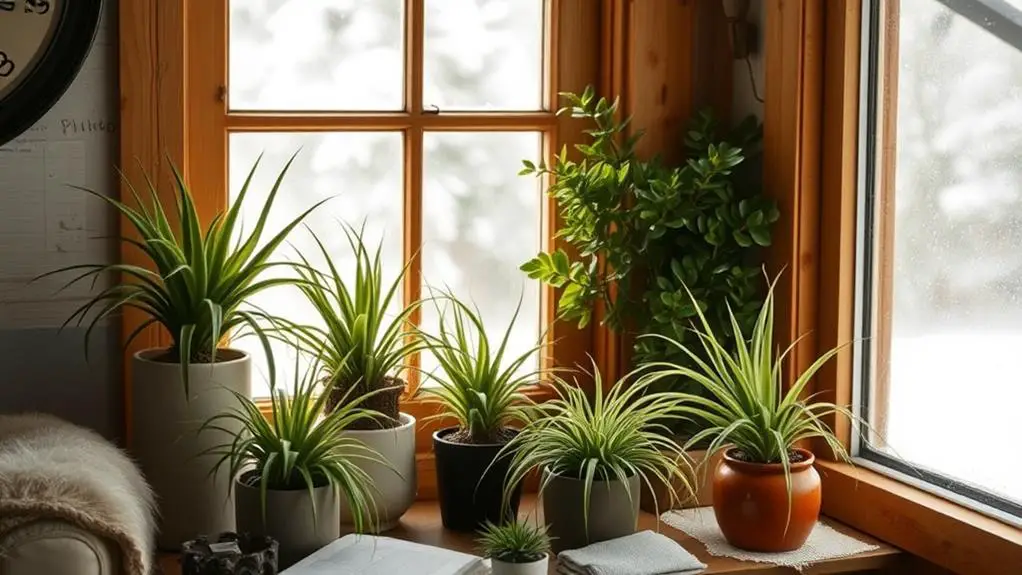
Maintaining the right temperature is essential for keeping your air plants healthy through the winter. Air plants thrive best in temperatures ranging from 50 to 90 degrees Fahrenheit, with a prime range of 65 to 85 degrees Fahrenheit for indoor conditions. It's important to avoid exposing them to temperatures below 50 degrees Fahrenheit, as this can cause stress and potential damage.
To guarantee effective temperature management, position your air plants indoors, away from cold drafts and sudden temperature fluctuations, especially during the winter months. Regularly monitor indoor temperature changes, especially if you're using heating sources, to maintain a stable environment.
Air plants prefer warm air, so placing them in well-lit areas where indirect light can provide additional warmth is beneficial.
Keep in mind that consistency is key. Sudden drops in temperature can be harmful, so make certain your plants are in a stable environment. If your home tends to get chilly, consider moving your air plants to a warmer room or using a small space heater to keep the temperature steady.
Light Requirements
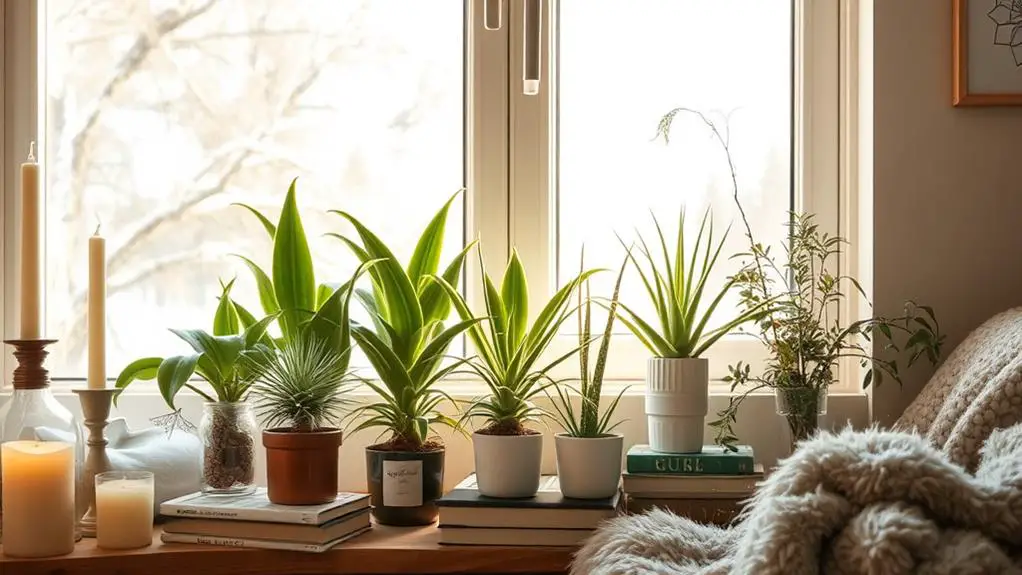
To guarantee your air plants stay healthy through the winter, they need at least 5 hours of bright, indirect sunlight each day. Positioning them correctly is key.
Place your air plants within several feet of south or west-facing windows to maximize their exposure to natural light, especially during the shorter winter days. Natural light mightn't always be sufficient, so consider using grow lights or fluorescent lighting to supplement their light needs.
Here's how you can make certain your air plants get the light they need:
- South or West-facing Windows: Place air plants a few feet away from these windows to catch the most light.
- Use Grow Lights: If natural light is lacking, set up grow lights to provide the necessary bright, indirect light.
- Monitor Plant Health: Watch for signs like stretched or pale leaves, which indicate insufficient light. Adjust the placement if needed.
- Avoid Incandescent Bulbs: These bulbs get too hot and can burn your air plants.
Air Circulation
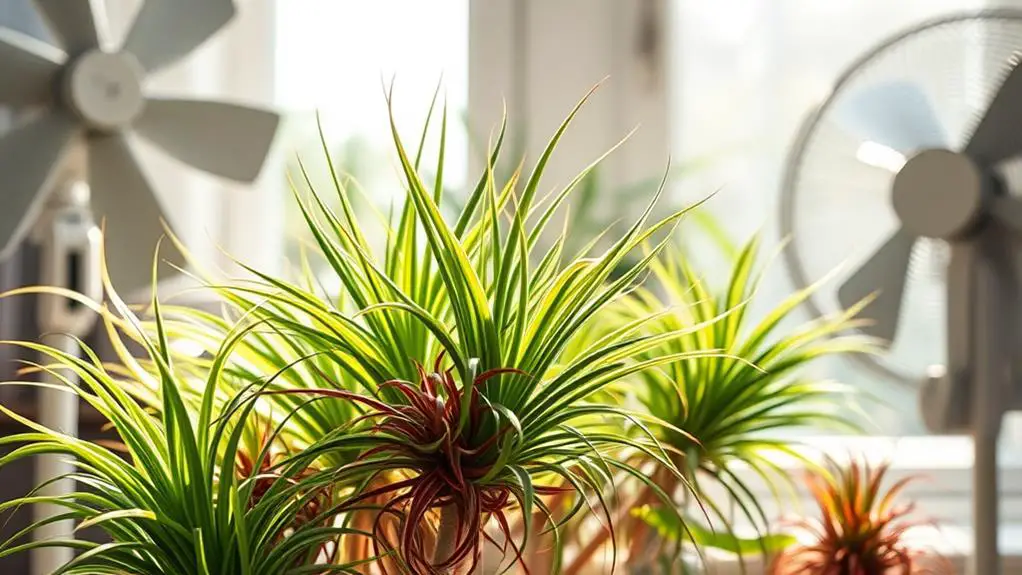
To keep your air plants healthy during winter, make sure they get plenty of airflow.
Avoid cramming them into tight spaces where air can't circulate well, as this can lead to mold or rot.
Keeping them away from heat vents and drafty windows will help prevent damage from temperature extremes.
Ensure Proper Ventilation
Your air plants' health hinges on guaranteeing proper ventilation, which allows them to effectively absorb nutrients and moisture. Adequate air circulation is essential for preventing issues like mold and rot.
Here are some key steps to help you guarantee proper ventilation for your air plants:
- Avoid Cramped Conditions: Don't place your air plants in closed terrariums or other tight spaces. They need room for air to flow freely around them.
- Position Wisely: Keep your air plants away from cold drafts, such as those from drafty windows and doors. However, make sure they're still in areas with good ventilation.
- Check for Stagnant Air: Regularly inspect your plant displays for stagnant air. Lack of movement can lead to unhealthy growth and increased disease risk.
- Rotate Regularly: Rotate your air plants occasionally to guarantee they receive even airflow and light exposure. This promotes overall health and growth.
Providing indirect sunlight or placing your plants in areas with natural light will also help maintain their importance.
Just follow these simple steps, and your air plants will thrive even during the colder months. Your attention to their environment makes all the difference!
Avoid Stagnant Conditions
Stagnant air can spell trouble for your air plants, leading to issues like mold, rot, and poor nutrient absorption. To guarantee your plants thrive, it's essential to avoid stagnant conditions and promote good airflow.
Place your air plants in areas with ample air circulation. Open spaces work best because they allow air to flow freely around the plants, enhancing their ability to absorb nutrients.
Avoid cramped display conditions or terrariums that restrict ventilation. Stagnant air in these enclosed spaces can quickly lead to unhealthy plants. You should regularly rotate your air plants to guarantee even air exposure and prevent localized stagnation. This simple step can make a big difference in their overall health.
Maintain a balance between humidity and air circulation. While air plants enjoy some humidity, too much without good airflow can create conditions perfect for mold growth.
Monitor the environment to guarantee it's not too humid, and adjust it if necessary. Keep an eye on your plants and the spaces they inhabit. By doing these things, you'll help your air plants avoid stagnant conditions and provide them with the best chance to thrive through the winter months.
Frequently Asked Questions
What to Do With Air Plants in the Winter?
Move your air plants indoors when temperatures drop to the 40s°F. Mist more often to combat dryness, guarantee at least 5 hours of indirect light, and water every two weeks. Monitor for stress signs like curling leaves.
How Often Do You Soak Air Plants in the Winter?
You should soak your air plants once a week during winter. In especially dry climates, increase the frequency to every 5-7 days. Always let them dry for at least 4 hours after soaking to prevent rot.
What Temperature Is Too Cold for Air Plants?
You should keep air plants above 50°F. Temperatures below 40°F can stress and damage them. Guarantee your indoor environment stays between 55°F and 85°F during winter to keep your air plants healthy and thriving.
Is It Better to Mist or Soak Air Plants?
It's better to soak air plants weekly for thorough hydration, especially in dry conditions. Misting can be a good supplement between soaks. Watch for wrinkled leaves, which indicate dehydration and a need for more frequent hydration.
Conclusion
You've got this! Winterizing your air plants is simple with these steps. Just remember to move them indoors when it gets chilly, keep the temperature steady, and give them plenty of light and water. Watch for any signs of stress and adjust their care if needed. With a little attention, your air plants will thrive all winter long. Don't worry, you're doing great, and your plants will thank you for the extra love!



